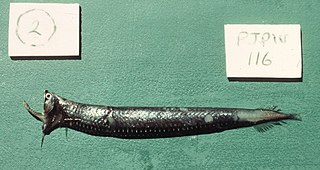
Stomiiformes is an order of deep-sea ray-finned fishes of very diverse morphology. It includes, for example, dragonfishes, lightfishes, loosejaws, marine hatchetfishes and viperfishes. The order contains 4 families with more than 50 genera and at least 410 species. As usual for deep-sea fishes, there are few common names for species of the order, but the Stomiiformes as a whole are often called dragonfishes and allies or simply stomiiforms.

The Pacific viperfish, Chauliodus macouni, is a predatory deep-sea fish found in the North Pacific. It is reported as being either mesopelagic or bathypelagic, with diel vertical migration to shallower waters. The Pacific viperfish is one of the nine different species that belong to the genus Chauliodus, the viperfish. The Pacific viperfish tend to be the largest of the species, typically reaching lengths of up to 1 foot and are considered an example of deep-sea gigantism. The length-weight relationship of the pacific viperfish varies with sex with females tending to be longer and heavier than males.

Pelagic fish live in the pelagic zone of ocean or lake waters—being neither close to the bottom nor near the shore—in contrast with demersal fish that do live on or near the bottom, and reef fish that are associated with coral reefs.

A viperfish is any species of marine fish in the genus Chauliodus. Viperfishes are mostly found in the mesopelagic zone and are characterized by long, needle-like teeth and hinged lower jaws. A typical viperfish grows to lengths of 30 cm (12 in). Viperfishes undergo diel vertical migration and are found all around the world in tropical and temperate oceans. Viperfishes possess photophores along the ventral side of their body, likely used to camouflage them by blending in with the less than 1% of light that reaches to below 200 meters depth.

Maurolicus muelleri, commonly referred to as Mueller's pearlside,Mueller's bristle-mouth fish, or the silvery lightfish is a marine hatchetfish in the genus Maurolicus, found in deep tropical, subtropical and temperate waters of the Pacific Ocean and the Atlantic Ocean, from the surface to depths of 1,500 metres (4,900 ft). It can grow to a maximum total length of 8 centimetres (3.1 in).

Sloane's viperfish, Chauliodus sloani, is a predatory mesopelagic dragonfish found in waters across the world. The species was first described by German scientists Marcus Elieser Bloch and Johann Gottlob Schneider in their 1801 book Systema ichthyologiae: iconibus CX illustratum, volume 1. Female C. sloani reach maturity between 133 and 191 mm, while males likely reach maturity at slightly smaller body lengths. It has two rows of photophores along its ventral side. It is believed that C. sloani can adjust the intensity of bioluminescence of the ventral photophores to camouflage itself from predators that might see its shadow from below.
Stomias boa boa, also called the scaly dragonfish or boa dragonfish, is a subspecies of abyssal barbeled dragonfish of the family Stomiidae. It is found at great depths worldwide in tropical to temperate oceans but is absent from the northern Pacific and northwest Atlantic Oceans.

Electrona is a genus of lanternfishes in the family Myctophidae.

The humpback anglerfish is a species of black seadevils in the family of Melanocetidae, which means "black whale" in Greek. The species is named after James Yate Johnson, the English naturalist who discovered the first specimen in Madeira in 1863. The common names include anglerfish, viperfish and fangtoothfish.

Stomias is a genus of barbeled dragonfishes. They live in the mesopelagic zone of all oceans and show diel vertical migration and sexual dimorphism (males are smaller, have larger eyes and larger postorbital photophores than females.

Argyropelecus affinis is a species of ray-finned fish in the family Sternoptychidae, found in the tropical and subtropical Atlantic, Indian and Pacific Oceans. Common names for this fish include Pacific hatchetfish, deepsea hatchetfish and slender hatchetfish. It inhabits the mesopelagic zone and is either non-migratory or performs short daily vertical migrations.

Sternoptyx diaphana, the diaphanous hatchetfish, is a species of deep sea ray-finned fish in the family Sternoptychidae. It is the type species of the genus Sternoptyx, and was first described by the French naturalist Johann Hermann in Der Naturforscher 1781.
Astronesthes richardsoni, or Richardson's snaggletooth, is a species of small, deep sea fish in the family Stomiidae. It occurs in the tropical western Atlantic Ocean, the Caribbean Sea and the Gulf of Mexico. First described by the Cuban zoologist Felipe Poey in 1852, it was named Chauliodus richardsoni in honour of the Scottish explorer and naturalist John Richardson. It was later transferred to the genus Astronesthes.

Astronesthes niger, commonly known as snaggletooth, is a species of small, deep sea fish in the family Stomiidae. It occurs in the tropical and subtropical Atlantic Ocean, the Caribbean Sea and the Gulf of Mexico, as well as the Indian Ocean and western Pacific Ocean, at depths to 1,000 m (3,300 ft).
Notoscopelus bolini is a species of lanternfish in the family Myctophidae. It is found in the North Atlantic Ocean and the Mediterranean Sea. It was first described in 1975 by the American ichthyologist Basil Nafpaktitis and named in honour of the American marine biologist Rolf Ling Bolin who had reviewed the genus in 1959.
The blackhead salmon is a species of fish in the family Alepocephalidae (slickheads).
The bigeye rockling is a species of fish in the family Lotidae.
Maul's searsid, also called Maul's tubeshoulder, is a species of fish in the family Platytroctidae (tubeshoulders), named for Günther Maul.

Stomias boa, also known as the boa dragonfish, scaly dragonfish, dragon-boa or boa scaly dragonfish, is a species of deep-sea fish in the family Stomiidae.
Stomias boa ferox is a subspecies of deep-sea fish in the family Stomiidae.














